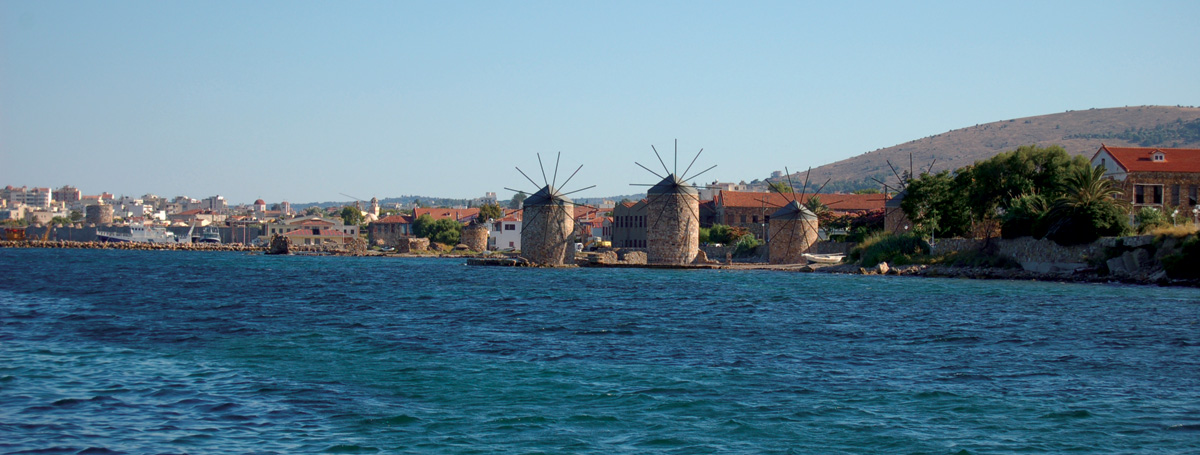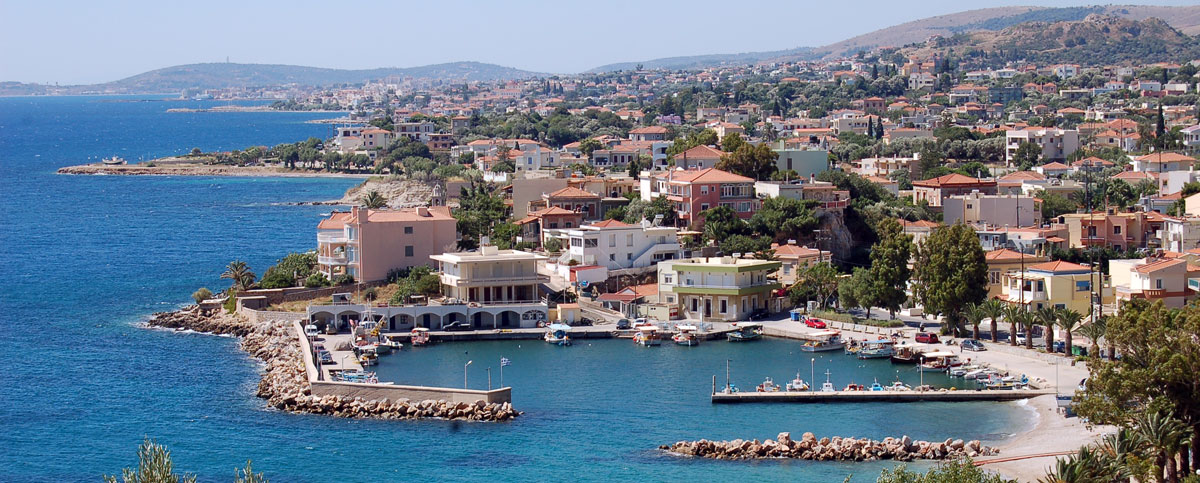
During antiquity the island was known as PITYOÚSA (many pines) and MÁKRIS (due to its long shape). During Homeric times it was called PAIPALÓESSA, meaning rocky. The name “CHÍOS” was taken from the mythological son of the sea god Poseidónas. The island was inhabited from the Stone Age (findings in Ágios Gálas).
During the 16th century BC, Pelasgians came to the island from Thessalía in mainland Greece. They were followed by Cretans, Évvoians and finally in the 9th to 7th centuries BC Iones from Attikí established themselves on the island. Since then, Chíos was one of the twelve members of the Ionian Confederation.
When Persians conquered Ionía (coasts of western Asia Minor) Chíos did not bow down but instead developed into a mighty naval force. Indeed in the 499BC sea battle of Ládi (near Mílito), Chíos did not back down, as did the other Ionian cities, but instead confronted 100 of the 600 Persian triremes and when they were finally defeated, the Persians ravaged the island (Heródotos).
However in 479BC the island belonged to the Athenian Allies and took part in the battles of Greece against the Persians in Plataiés and Mykáli of Ionía. Naturally, Chíos took the part of the Athenians (Íones) in their rift with the Spartians (Dorians). Towards the end of the 4th century BC the island was captured by the Makedónes and at the beginning of the 2nd century BC fell into Roman hands. Mythridátis (king of Póntos) completely destroyed the city of Chíos at the beginning of the 1st century BC and removed all of its wealth and most of its inhabitants to Kolchída in Póntos. One year later the Romans freed the city and granted its independence. Ágios Isídoros, patron saint of the island, was martyred in Chíos in 250 AD.
From the 4th century AD the island belonged to the Byzantine and suffered the piratical raids of the Saracens for 4 centuries (7th – 11th). For the effective defence of the island the Byzantines built the Fortress of Chíos in the 11th century. Because of its strong position the island became an important commercial centre and attracted many Genoan merchants. From the beginning of the 14th century the island belonged to the Genoans, who ran the island up until the 16th century when the Turks captured it (The Genoans surrendered without battle.)
According to many historians Christopher Columbus visited the island in the 15th century to get supplies of charts, information and sailors from Chíos for his long voyage. Chíos blossomed under Turkish rule. It is said that both the nautical inhabitants and the production of mastic (a type of gum for the Sultan’s supplies) insured the prosperity and progress of the island. However, during the Greek Revolution against the Turkish conquerors in 1821, Chíos was met with the atrocious crime of its destruction.
This drama, which became renown in international history as “The massacre of Chíos” disturbed many artists, such as Victor Hugo and the French painter Delacroix as well as many others. In a few words the story is as follows (summary taken from the “History of the Greek State”): After the successes of the Samians against the Turks, Chíos also started to rebel. The Samian Lykoúrgos Logothétis disembarked on Chíos with 2500 Samians to help reinforce the islanders. The Sultan sent over his fleet with 15,000 soldiers, who joined forces with the Turkish force already on the island, in order to punish the islanders. After having defeated and slaughtered 3000 Greek warriors in the Monastery of Ag. Minás, they turned towards the village of Ág. Geórgios, where the Samians and the rest of the Chíos warriors were. However, the Samians changed their mind and returned to their island without a fight, leaving the Chíos men on their own, who eventually were defeated.
After their victories the Turkish Admiral Cara Ali sent the ambassadors of Austria, England and France to declare amnesty and to persuade the villagers back to their homes and to give up their arms. Once this had happened, history repeated itself and the Turkish Admiral broke his word, by ordering a general bloodshed and imprisonment of the inhabitants. From a population of over 100,000, only 2000 remained in Chíos. 30,000 people were put to death and 47,000 were taken prisoner or sold as slaves. The remaining 21,000 managed to flee to the rest of Greece. This all took place during April 1822. The Psarian Constantínos Canáris took revenge for this crime with his fireship two months later in the beginning of June. During Greek operations against the Turks in the Strait of Chíos, the intrepid admiral stuck his fireship to the Turkish flagship with its 84 cannons and set fire to it. The Turkish Admiral Cara Ali, who had ordered the massacre of Chíos, met his downfall in this disaster. The English historian Gordon wrote that the burning of the Turkish flagship was one of the greatest accomplishments in world history. The Turkish retaliation against whomever and whatever was left on the island was heavy. An ensuing attempt by the Greeks in 1827 to free the island was unsuccessful, one of the reasons being the general disheartenment felt by the inhabitants of Chíos. The island was finally freed by a landing regiment of the Armed Greek Forces, who disembarked in Kontári, 4km south of the capital, in the beginning of November 1912.
Chíos, throughout the ages, has been characterised for its contribution to the arts, the nautical ability of its people (today’s shipowners, captains and crew uphold the tradition of the Iones, the first Greek nautical folk, as the people of Chíos were themselves Iones), the atrocious crime of its massacre by the Turks and for its mastic (gum). The very first Democracy appeared on this island during the Historic Age. Legend has it that Sólonas, the great legislator of Athína, visited the island to study its regime before establishing it in Athína. The ancient Greeks thought that this was one of the “Makáron” (happy, blessed) islands.

Sightseeing
There are many mediaeval villages worth visiting, such as Olýmpoi, Pyrgí, Mestá, Anávatos and Volissós, which are a model of defensive architecture.
The Mastic Villages with their “xystá”, a special decorative element based on geometrical shapes, are also worth a visit.
Among the churches and monasteries (Ágios Isídoros, Agía Merópi and Agía Markélla were all martyred on the island) the Néa Moní (mid 11th century 22710 79391) has a special place as one of the most important monuments on the island and of Greek Orthodoxy. It should be visited so you can admire the high Byzantine art and feel humble before the light that washes over you from the windows of its imposing dome.
Kámpos is the fertile plain of Chíos. You will be impressed by the glorious manor houses, the continual stone walls that hide the courtyards and houses, as well as by the grand entrances to the estates made from the same red stone.

Flavours
Mastic dominates in the island. It is an aromatic gum that comes from scratching the mastic tree. Well known since antiquity, it abounds in many medical prescriptions of that time. The amazing thing is that this brushy tree grows only in southern Chíos and nowhere else.
You will enjoy the red mullet of Chíos, it is a very sweet fish (the Romans said it was among the best). For wine try the white barrel wine, which is very nice. Also the “masourákia” (known as “flogéres” in many parts of Greece) are excellent. Finally, do not forget to accompany your coffee with the famous sweets of the island.





